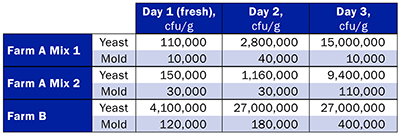
What’s growing: Understanding yeasts and molds – Jon Urness and Dr. Michelle Windle, Vita Plus
 By Jon Urness, Vita Plus national forage specialist, and Dr. Michelle Windle, Vita Plus forage products and dairy technical service specialist
By Jon Urness, Vita Plus national forage specialist, and Dr. Michelle Windle, Vita Plus forage products and dairy technical service specialistLast November, we received a call from a Vita Plus consultant in southwest Wisconsin asking about some yeast and mold counts. He was helping a producer determine the effects of mixing a TMR and feeding it only once every three days to his prefresh group. He took samples on each of the three days and submitted them for analysis. He repeated this twice (Mix 1 and 2 from Farm A). We sampled another mix for comparison in a similar way (Farm B).
Yeast and mold counts in prefesh rations fed once every third day.

We discussed the results and first determined that the mold counts generally weren’t that high. Dairyland Laboratories, Inc. considers mold counts up to 1 million colony forming units (cfu) per gram relatively safe; 1 to 2 million should be fed with caution; and greater than 2 million are cause for concern and should be fed with caution.
What about those crazy yeast numbers? Why aren’t we seeing higher mold counts associated with these high yeast counts?
 Relating yeasts and molds
Relating yeasts and molds
Yeast and mold counts reflect spoilage – an oxygen issue. Upon oxygen exposure, such as during feedout, yeasts awaken and consume nutrients, specifically lactic acid, which raises pH. With a higher pH, molds can grow. It is important to understand a lag exists between yeast growth and mold growth because yeast activity is necessary to prepare the environment (a higher pH) for mold growth. Thus, the progression of spoilage is:
- Oxygen enters the silo
- Yeasts revive and consume nutrients and lactic acid
- pH increases
- Molds revive
- Microbial growth creates heat
- Feed quality plummets
In this example, yeast numbers started higher in Farm B than Farm A (day 1). Thus, Farm B spoiled faster.
In Farm B, yeasts increased from day 1 to 2, and plateaued between days 2 and 3, as they consumed nutrients and raised the pH. As a result of the higher pH, mold numbers increased.
We also observed a lag between yeast and mold growth in Farm A: On day 2, yeast numbers were increasing, but still low. By day 3, yeasts grew substantially, but mold growth hadn’t taken off yet. Presumably, if this experiment continued, numbers of yeast would peak, plateau, and then die (due to a depletion of nutrients and eventual starvation), followed by a similar trend in mold numbers.
Let’s go back to the original field trial of mixing and feeding a TMR once every three days. Data from this set underscore that it is unacceptable to feed only every third day.
Many assume that if feed is not visibly spoiled, it is fine to feed. In reality, once molds are visible, silage has already been spoiled for days. Feeding spoilage yeasts to ruminants results in decreased intake, production, and digestibility, and affects rumen fermentation of unspoiled feed, resulting in major economic losses. That’s why we always recommend mixing a fresh batch of feed daily. If you won’t eat spoiled food, why should we expect our cows to eat it?
| Category: |
Feed quality and nutrition Forage Foundations Mycotoxins |

